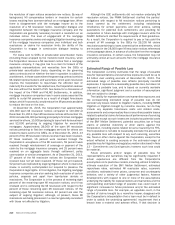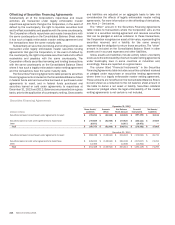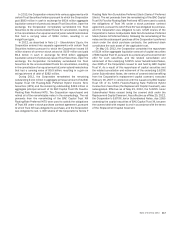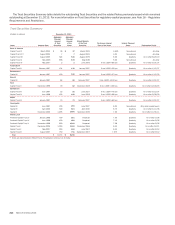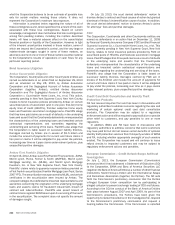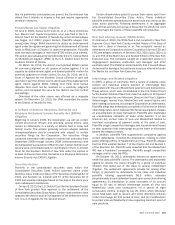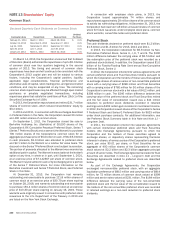Bank of America 2013 Annual Report Download - page 222
Download and view the complete annual report
Please find page 222 of the 2013 Bank of America annual report below. You can navigate through the pages in the report by either clicking on the pages listed below, or by using the keyword search tool below to find specific information within the annual report.220 Bank of America 2013
Other Guarantees
Bank-owned Life Insurance Book Value Protection
The Corporation sells products that offer book value protection to
insurance carriers who offer group life insurance policies to
corporations, primarily banks. The book value protection is
provided on portfolios of intermediate investment-grade fixed-
income securities and is intended to cover any shortfall in the
event that policyholders surrender their policies and market value
is below book value. These guarantees are recorded as derivatives
and carried at fair value in the trading portfolio. At both December
31, 2013 and 2012, the notional amount of these guarantees
totaled $13.4 billion and the Corporation’s maximum exposure
related to these guarantees totaled $3.0 billion with estimated
maturity dates between 2030 and 2045. The net fair value
including the fee receivable associated with these guarantees was
$39 million and $52 million at December 31, 2013 and 2012,
and reflects the probability of surrender as well as the multiple
structural protection features in the contracts.
Employee Retirement Protection
The Corporation sells products that offer book value protection
primarily to plan sponsors of the Employee Retirement Income
Security Act of 1974 (ERISA) governed pension plans, such as 401
(k) plans and 457 plans. The book value protection is provided on
portfolios of intermediate/short-term investment-grade fixed-
income securities and is intended to cover any shortfall in the
event that plan participants continue to make qualified withdrawals
after all securities have been liquidated and there is remaining
book value. The Corporation retains the option to exit the contract
at any time. If the Corporation exercises its option, the investment
manager will either terminate the contract or convert the portfolio
into a high-quality fixed-income portfolio, typically all government
or government-backed agency securities, with the proceeds of the
liquidated assets to assure the return of principal. To manage its
exposure, the Corporation imposes restrictions and constraints
on the timing of the withdrawals, the manner in which the portfolio
is liquidated and the funds are accessed, and the investment
parameters of the underlying portfolio. These constraints,
combined with significant structural protections, are designed to
provide adequate buffers and guard against payments even under
extreme stress scenarios. These guarantees are recorded as
derivatives and carried at fair value in the trading portfolio. At
December 31, 2013 and 2012, the notional amount of these
guarantees totaled $4.6 billion and $18.4 billion with estimated
maturity dates up to 2017 if the exit option is exercised on all
deals. The decline in notional amount in 2013 was primarily the
result of plan sponsors terminating contracts pursuant to exit
options. As of December 31, 2013, the Corporation had not made
a payment under these products.
Indemnifications
In the ordinary course of business, the Corporation enters into
various agreements that contain indemnifications, such as tax
indemnifications, whereupon payment may become due if certain
external events occur, such as a change in tax law. The
indemnification clauses are often standard contractual terms and
were entered into in the normal course of business based on an
assessment that the risk of loss would be remote. These
agreements typically contain an early termination clause that
permits the Corporation to exit the agreement upon these events.
The maximum potential future payment under indemnification
agreements is difficult to assess for several reasons, including
the occurrence of an external event, the inability to predict future
changes in tax and other laws, the difficulty in determining how
such laws would apply to parties in contracts, the absence of
exposure limits contained in standard contract language and the
timing of the early termination clause. Historically, any payments
made under these guarantees have been de minimis. The
Corporation has assessed the probability of making such
payments in the future as remote.
Merchant Services
In accordance with credit and debit card association rules, the
Corporation sponsors merchant processing servicers that process
credit and debit card transactions on behalf of various merchants.
In connection with these services, a liability may arise in the event
of a billing dispute between the merchant and a cardholder that
is ultimately resolved in the cardholder’s favor. If the merchant
defaults on its obligation to reimburse the cardholder, the
cardholder, through its issuing bank, generally has until six months
after the date of the transaction to present a chargeback to the
merchant processor, which is primarily liable for any losses on
covered transactions. However, if the merchant processor fails to
meet its obligation to reimburse the cardholder for disputed
transactions, then the Corporation, as the sponsor, could be held
liable for the disputed amount. In 2013 and 2012, the sponsored
entities processed and settled $623.7 billion and $604.2 billion
of transactions and recorded losses of $15 million and $10 million.
A significant portion of this activity was processed by a joint venture
in which the Corporation holds a 49 percent ownership. At
December 31, 2013 and 2012, the sponsored merchant
processing servicers held as collateral $203 million and $202
million of merchant escrow deposits which may be used to offset
amounts due from the individual merchants.
The Corporation believes the maximum potential exposure for
chargebacks would not exceed the total amount of merchant
transactions processed through Visa and MasterCard for the last
six months, which represents the claim period for the cardholder,
plus any outstanding delayed-delivery transactions. As of
December 31, 2013 and 2012, the maximum potential exposure
for sponsored transactions totaled $258.5 billion and $263.9
billion. However, the Corporation believes that the maximum
potential exposure is not representative of the actual potential
loss exposure and does not expect to make material payments in
connection with these guarantees.
Other Derivative Contracts
The Corporation funds selected assets, including securities issued
by CDOs and CLOs, through derivative contracts, typically total
return swaps, with third parties and VIEs that are not consolidated
by the Corporation. The total notional amount of these derivative
contracts was $1.8 billion and $2.9 billion with commercial banks
and $1.3 billion and $1.4 billion with VIEs at December 31, 2013
and 2012. The underlying securities are senior securities and
substantially all of the Corporation’s exposures are insured.
Accordingly, the Corporation’s exposure to loss consists principally
of counterparty risk to the insurers. In certain circumstances,
generally as a result of ratings downgrades, the Corporation may
be required to purchase the underlying assets, which would not
result in additional gain or loss to the Corporation as such exposure
is already reflected in the fair value of the derivative contracts.


